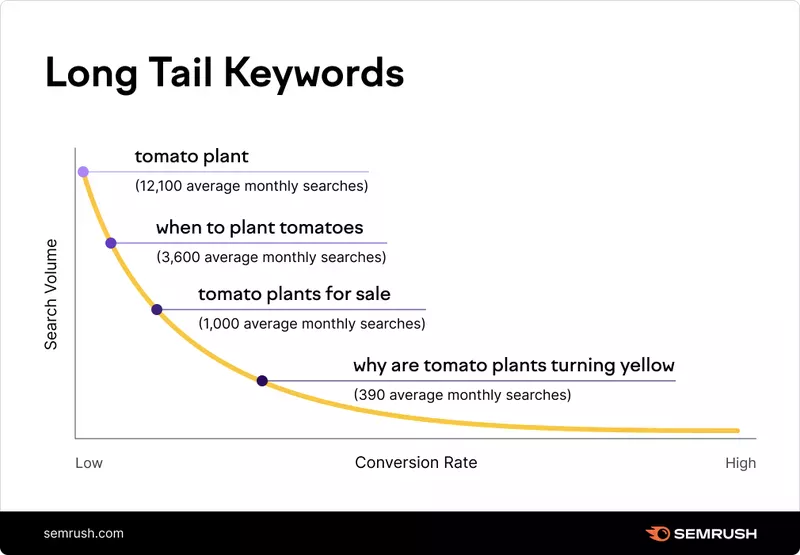If you want your Web site to rank well in search engines and attract visitors, it is important to use the right keywords. Many people focus on short, popular keywords. However, smart marketers know that long-tail keywords can offer a lot of value. In this guide, we explain what long-tail keywords are, why they are important and how to find and use them.
Compare ordering “coffee” in a café ordering a “large latte with almond milk and a touch of cinnamon“. The first order (short keywords) is general and can mean anything, while the second order (long-tail keywords) is specific and specifies exactly what you want. The café can serve you better if you specify exactly what you want, just as search engines can serve you better if you use specific keywords.
What are Long-Tail Keywords?
Long-tail keywords are longer, more specific keyword phrases that visitors use when they are closer to a purchase or when they do voice search. These keywords often have lower search volume than short keywords, but are more targeted.

For example, “shoes” is a broad keyword. But “best price for running shoes for flat feet” is a long-tail keyword. It is more specific and focuses on exactly what the searcher wants.
The term “long-tail” comes from the book The Long Tail by Chris Anderson. If you were to plot all keywords based on their search volumes, you would get a graph showing a “long tail” of keywords that are searched for less frequently. Together, these long-tail keywords may make up the bulk of web searches.
The Benefits of Long-Tail Keywords
Less Competition
The biggest advantage of long-tail keywords is that they are less competitive. Trying to rank for broad keywords such as “shoes” or “insurance” is very difficult. Long-tail keywords have lower search volume, so fewer websites compete to rank for them. That means you have a better chance of ranking on the first page.
Higher Conversion Rates
Long-tail keywords also have higher conversion rates. That’s because people searching for something very specific are often further along in the buying cycle. Someone searching for “best price Nike Air Zoom Pegasus 38” is probably ready to buy.
Better for Voice Search
Optimization for long-tail keywords is also important for voice search. When people use Siri, Google Assistant or Alexa, they ask longer, natural questions. For example, someone might ask “how do you make cold coffee?” instead of just “cold coffee.”
Scoring Faster with New Content
Trying to rank for short keywords takes a lot of time and effort. But you can often get new pages for long-tail keywords to rank much faster, even if your site is new or has a lower domain authority.
How to Find the Best Long-Tail Keywords?
Use Keyword Research Tools
Keyword research tools such as Google Keyword Planner, Ahrefs and Moz are very useful for finding long-tail keywords. Enter a broad keyword and they provide a list of related long-tail variants, along with their search volumes and difficulty.
Analyze Your Search Report
Your Google Search Console account contains a lot of useful data about long-tail keywords. Go to the Performance report and look at the searches that send impressions and clicks to your site. You will probably find long-tail keywords for which you are already accidentally scoring by creating relevant content.
Use “People Also Ask”
Every time you search for a keyword on Google, you usually see a “People also ask” box with questions related to your original search. These questions are great long-tail keyword ideas.
Forums and Q&A Sites
Forums such as Reddit and Quora are gold mines for long-tail keyword research. People ask very specific questions on these sites that mirror the kind of long-tail searches they do on Google.
How to Optimize for Long-Tail Keywords?
Use the Exact Keyword Phrase
Make sure you include your exact long-tail keyword verbatim in your text. Use it in the title, meta description, URL, H1 header, and a few times in the text.
Use Variations and Synonyms
You should also include variations and synonyms of your main phrase. This helps you score for long-tail variations and tells Google that your text covers the topic well.
Optimize for Search Intent
When targeting long-tail keywords, it is important to match the search intent behind the query. If someone searches for “how to make cold brew coffee,” they want a step-by-step guide, not a product page.
Build Internal Links
Linking to your new long-tail optimized pages from other relevant pages on your site helps them get indexed faster and rank better.
FAQ on Long-Tail Keywords
What are long-tail keywords? Long-tail keywords are longer and more specific search phrases that are less frequently searched, but are often more relevant to what people really want to find.
How do I find long-tail keywords? You can use tools such as Google Keyword Planner, Ahrefs and Moz. You can also look at searches in your Google Search Console and Google’s “People also ask” section.
Why are long-tail keywords important? They have less competition, higher conversion rates, are better for voice search and you can score faster with new content.
How do I use long-tail keywords? Use exact phrases in your title, meta description, URL, H1 header, and text. Also use variations and synonyms, and make sure your content matches the search intent.






